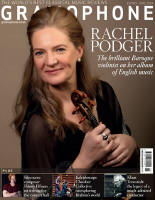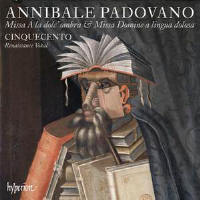Texte paru dans: / Appeared in:
Hyperion CDA68407
|
|
 |
|
|
A tale of two Masses, one based on a madrigal, the other on a motet.
Cinquecento’s latest release, coupling Annibale Padovano’s Missa A la dolc’ ombra and Missa Domine a lingua dolosa offers a captivating glimpse into compositions by an Italian composer much lauded in his own time but little remembered since. Padovano occupied a place in the musical life of St Mark’s, Venice, and in the circle around Adrian Willaert (also memorably recorded by this ensemble – 8/10), and later served in Graz at the court of Archduke Karl II. Describing him as ‘brilliant, cocky and mercurial’ in his comprehensive note, musicologist
Grantley McDonald points out Padovano’s predilection for highly consonant writing. He was famous for his instrumental works as much as for his Mass for 24 voices (recorded by the Huelgas Ensemble – Harmonia Mundi, 6/01), but this album presents the stylish polyphonist on a more modest scale.
Cinquecento as one of the current premiere all-vocal ensembles find much beauty and intricacy in Padovano’s ‘highly consonant’ style, reminding me that I once wrote: ‘Their sound is reminiscent of The Hilliard Ensemble, particularly in the delightful interplay of their two wellmatched tenors and the warmth of the overall blend captured through a close, warm recording technique’ (Palestrina’s Lamentations – 12/19). This still holds today, as the ensemble’s skilful blend is a happy marriage to Padovano’s ars perfecta flow. They also handle transition moments well, as best heard in the opening Kyrie of Missa A la dolc’ ombra, which cadences on a shimmering top-heavy chord so that the ‘Christe’ section feels inevitable. Contrast this with poignant homophonic textures at ‘Domine fili unigenite’ in the Gloria and you’ll get a sense of what an inventive setting this is. Despite the fine, intelligent singing, the Mass model, Cipriano de Rore’s epic madrigal A la dolc’ ombra, presents like a motet due to its calm, unhurried performance; perhaps this one piece might have benefited from more demonstrative delivery and crisper Italian.
Missa Domine a lingua dolosa is based on Padovano’s motet written in the unusual yet expressive Aeolian mode. It’s a low, mellow setting, which clearly inspires the singers of Cinquecento. Listen out for the superb bass notes throughout and a poised, elegant Benedictus duet. The ensemble expands for the final seven-voice Agnus Dei with glorious, indulgent results. Cinquecento at their best. |
|




